Underdocumented Medals
This page contains medals that I find interesting but don't know a lot–or anything–about. Please contact me if you can help out by shedding light on the medal's background, maker, mintage, designer, etc.
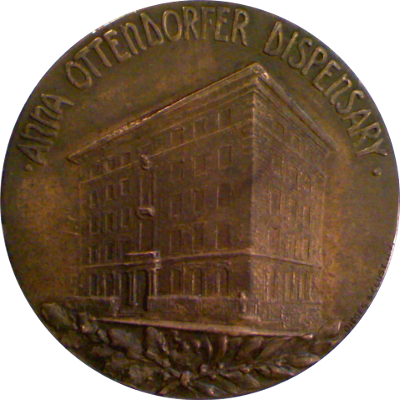
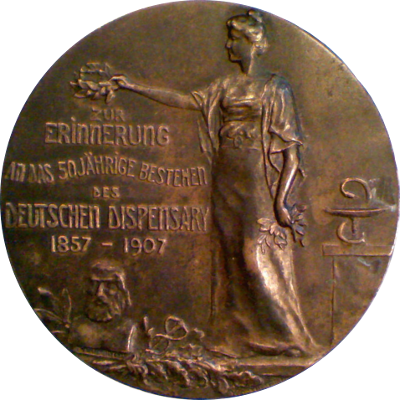
The obverse depicts the Anna Ottendorfer Dispensary in New York City, oak and laurel branches at bottom. Around, ANNA OTTENDORFER DISPENSARY; at bottom right, DIEGES & CLUST N.Y.
The reverse bears standing figure of Hygiea holding out wreath; medical implements at her feet and on table to her right. Inscription on left, ZUR / ERINNERUNG / AN DAS 50 JÄHRIGE BESTEHEN / DES / DEUTSCHEN DISPENSARY / 1857 - 1907 (IN REMEMBERANCE OF THE 50TH ANNIVERSARY OF THE GERMAN DISPENSARY)
This medal celebrates both an institution and a philanthropist of the late 19th century. Anna Ottendorfer (1815-1884) was the German-born wife of Jacob Uhl who purchased the New Yorker Staats-Zeitung, an influential and growing tri-weekly German-language newspaper in New York City. When her husband died in 1852 Anna took over and continued publishing the popular newspaper. She married the paper's editor, Oswald Ottendorfer, continued growing its circulation until, yy the 1870s, its circulation was comparable to English-language newspapers like the New York Tribune and the New York Times.
Throughout this time she was deeply concerned about the plight of poor German immigrants, particularly the women and children. She contributed $40,000 to an educational fund, built the women's pavilion of the German Hospital, New York City, at a cost of $75,000, and gave $100,000 for the German Dispensary. In 1883, Ottendorfer received a gold medal from the Empress Augusta of Germany in recognition of her aid to flood victims in that country in 1882 and 1883.
She did not survive to see the Dispensary open to the public. She died a few months before its completion. Her funeral was the largest up to that time for a woman in New York City; the eulogy was read by the famous German-American Carl Schurz.
The medals were handed out to the guests of a celebratory banquet at the Hotel Astor. While the artist is not known we now know (thanks to Julia Casey who located an article in the New York Times) that there were three variants of the medal: one gold piece which was handed to a daughter of Anna Ottendorfer, several silver pieces which were handed to speakers and guests and officers of the dispensary, and bronze pieces for the remaining attendees. As there were approximately 300 guests present we now have an idea about the overall mintage.
This circular medal measures 51mm in diameter and was struck by Dieges & Clust of New York.
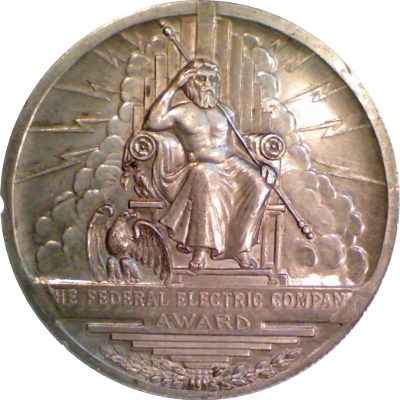
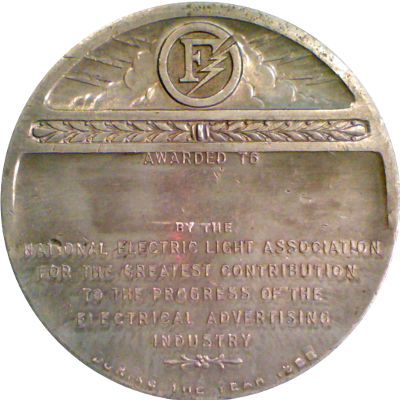
The medal's obverse bears god-like figure (Zeus?) on throne, eagle perched at throne's left, clouds and lightning in background. In exergue, THE FEDERAL ELECTRIC COMPANY / AWARD
The medal's reverse bears company's logo (circled F with lightning bolt) before clouds and lightning at top; below, horizontal branches of leaves. Inscription reading AWARDED TO / (blank space) / BY THE / NATIONAL ELECTRIC LIGHT ASSOCIATION / FOR THE GREATEST CONTRIBTION / TO THE PROGRESS OF THE / ELECTRICAL ADVERTISING / INDUSTRY / DURING THE YEAR 19(unreadable)
The edge is rifled and does not bear any maker's marks.
The Federal Electric Company was founded in Chicago, Illinois, in 1901 by John Goehst and James and John Gilchrist. The company started out by manufacturing and selling store signs lit by incandescent lamps. By 1915, they began manufacturing and selling electrically-operated mechanical sirens. In the 1920s, Federal Electric came under the ownership of Commonwealth Edison, eventually becoming a part of the utility empire of Samuel Insull.
In 1969 the company was spun off and went public as the Federal Signal Corporation. They are still operating under that name and "design, develop and deploy solutions intended to protect people, property and the environment under brands including Federal Signal, Elgin, Bronto, Vactor, Guzzler, Vactor, Victor, and Jetstream."
Do you know the artist who designed this medal or where it was manufactured? Please contact me if you have more information.
This medal measures 70mm in diameter and was struck in white metal.


The medal's obverse bears helmeted bust of Minerva, the Roman goddess of wisdom and sponsor of arts, trade, and strategy. Around left and right, THE DETROIT NEWS - SPELLING BEE; to left and right of Minerva, in vertical orientation, SCHOOL / CHAMPION; signed with (CHJ monogram)
The medal's reverse bears inscribed center field with surrounding decorative leaf border. At bottom over border, MADE IN HOLLAND; inscribed to Elaine Rosenbaum.
The edge is unmarked.
Van der Hoef (1875-1933) was a Dutch sculptor whose most productive period was in the 1910-20s. He bridged the Art Nouveau and Art Deco periods and created many art and commemorative medals. In addition to his artistic talents he also competed in the 1928 Olympic Games in Amsterdam where he won a silver medal.
I did not manage to find much information about the history of the Detroit News Spelling Bee. The medal design dates to 1929, which would indicate that the Bee started around the same time. There are at least the 40mm School Champion and the 51mm District Champion variants; there might be others for city or state. Please let me know if you have more information about variants.
This circular medal measures 40mm in diameter and was struck in bronze.
Many thanks to Julia Casey who located information about the designer and the design in the University of Michigan's Bentley Image Bank.


The medal's obverse bears a woman representing Education sitting on a throne with opened book of knowledge in her lap and her arms raised in gesture of benediction; to her left, a little girl holding a book and a young man in graduation dress clutching diploma; to her right, a young boy reading and a young woman in graduation dress, reverently holding a book. Below, ERUDITIO / POPULI OPUS SUPREMUM REIPUBLICAE
The medal's reverse bears two burning torches flanking inscription THE / NEW YORK ACADEMY / OF PUBLIC EDUCATION / AWARD FOR / DISTINGUISHED SERVICE / TO PUBLIC EDUCATION / TO; empty rectangle for dedication.
Bottom edge bears maker's mark MEDALLIC ART CO. N.Y.
I found no information about the history of the award program, though I did find the following in Columbia University's Annual Report of 1945:
"the award to Virginia C. Gildersleeve, Dean of Barnard College, of the Gold Medal of the National Institute of Social Sciences, and her designation as recipient of the Achievement Award in Education by the Women's National Press Club, and as recipient of the Award for Distinguished Service to Public Education by the New York Academy of Public Education;"
The medal itself was designed by Joseph Nicolosi (1893-1961), an Italian American sculptor who initially worked in New York City but then relocated to the West Coast.
This medal measures 95mm x 76mm and it was struck in bronze by the Medallic Art Company of New York.
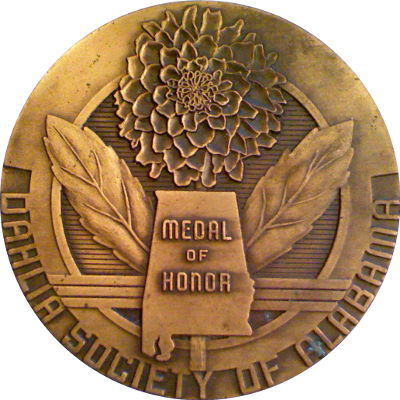

The obverse bears beautiful Art-Deco image of a Dahlia flower with two leaves, outline of State of Alabama over stem. Within state field, MEDAL / OF / HONOR; around bottom, DAHLIA SOCIETY OF ALABAMA
The reverse is blank with engraved inscription 1984 / SECTION VII / BEST 5 AA · A · B · BB
The design of this beautiful medal screams art -deco and the style is reminiscent of Rene Chambellan or Julian Harris, but I could not find any attribution for this medal. Any additional information about this medal would be very welcome.
This medal measures 76mm in diameter.
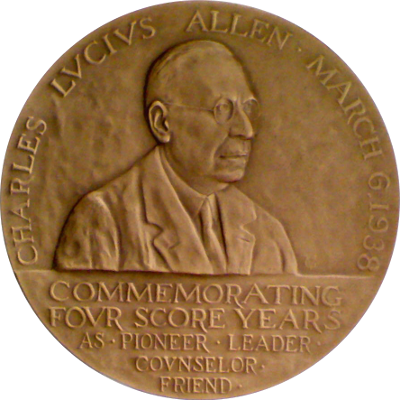
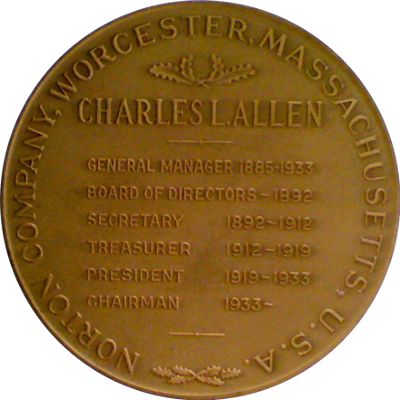
The medal's obverse bears bust of Allen, three quarters right. Around top, CHARLES LVCIVS ALLEN · MARCH 6.1938; in exergue, COMMEMORATING / FOVR SCORE YEARS / AS · PIONEER · LEADER · / COVNSELOR · / FRIEND ·; signed over exergue to right of bust, (VG monogram)
The reverse bears legend with some decorative elements. Around, NORTON COMPANY, WORCESTER, MASSACHUSETTS, U.S.A.; in center field, CHARLES L. ALLEN / GENERAL MANAGER 1885 · 1933 / BOARD OF DIRECTORS ~ 1892 / SECRETARY 1892 ~ 1912 / TREASURER 1912 ~ 1919 / PRESIDENT 1919 ~ 1933 / CHAIRMAN 1933 ~
The Norton Emery Wheel Company was founded by Milton P. Higgins, George I. Alden, John Jeppsen, and Charles L. Allen. The quartet bought out the original founder Franklin Norton who had invented a grinding wheel that was far superior to competing products of the day and was in great demand due to booming railroad construction and related industries.
Under Allen's guidance the company grew dramatically and is still the world's largest manufacturer of abrasives. Norton was acquired by Compagnie de Saint-Gobain of France but remains a presence in Worcester.
Do you have information on the artist who designed this medal? His or her initials are VG or GV (superimposed).
The circular medal measures 63.7mm in diameter and was struck in bronze by the L. G. Balfour Company of Attleboro, Massachusetts.

This uniface medal's obverse bears bust of Native American chief in feather headdress facing right. Around right side, YOSEMITE NAT'L PARK
The reverse bears maker's mark ROBBINS CO / ATTLEBORO / MASS
This beautiful medal bears no signature and no date. The design and craftsmanship make me believe that it was done by one of the better known medallists but I would really appreciate to get some data on this piece. I would date it no later than the 1940s, but I could be totally wrong.
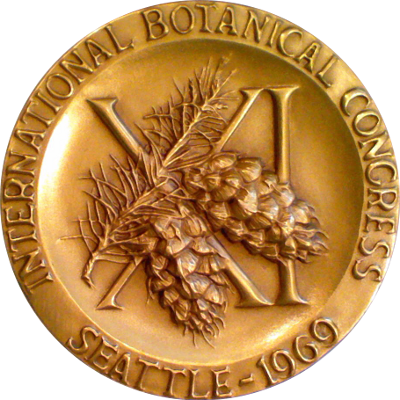
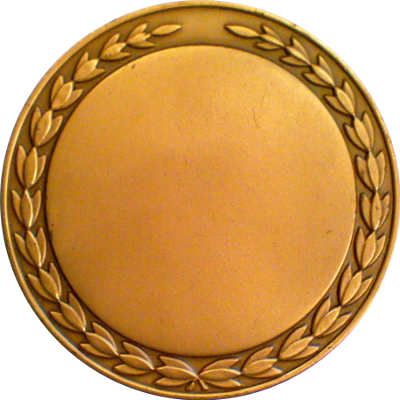
The obverse bears pine branch with two cones over large XI. Around, INTERNATIONAL BOTANICAL CONGRESS / SEATTLE ~ 1969
The reverse is blank except for a decorative wrerath running around the edge.
I finally identified this medal's artist with the help of Dick Johnson's excellent reference on American medallic art.
This medal was struck by the Medallic Art Company of New York.
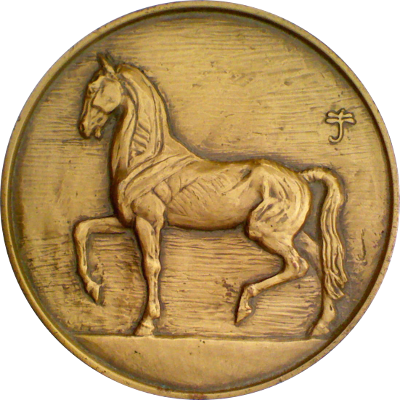
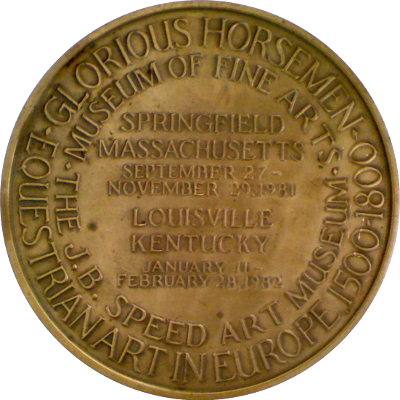
The obverse bears horse in dressage stance. Signed at upper right with dragonfly-reminiscent (J monogram).
The reverse bears only text. In center field, SPRINGFIELD / MASSACHUSETTS / SEPTEMBER 27 - / NOVEMBER 29, 1981 / LOUISVILLE / KENTUCKY / JANUARY 11 - / FEBRUARY 28, 1982; around, · GLORIOUS HORSEMEN · / EQUESTRIAN ART IN EUROPE 1500-1800 / · MUSEUM OF FINE ARTS · / THE J.B.SPEED ART MUSEUM
The edge is marked © 1981 MACO - BRONZE
This medal accompanied a joint exhibition by the Museum of Fine Arts of Springfield, Massachusetts and the J.B. Speed Art Museum of Louisville, Kentucky.
The circular medal measures 73mm in diameter and was struck in bronze by the Medallic Art Company. No mintage was reported. Please contact me if you know the sculptor.
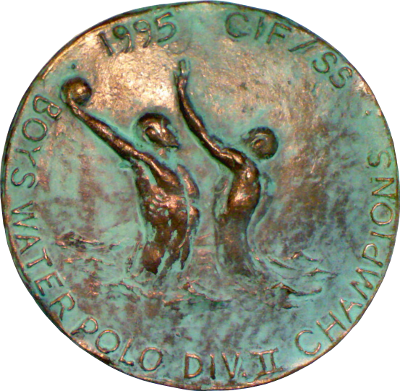

The obverse bears two waterpolo players rising out of water, one trying to block the other's throw. Around, BOY'S WATER POLO DIV.II CHAMPIONS - 1995 - CIF / SS
The reverse bears nude young man standing next to stylized logo CIF with laurel wreath inside the letter C. In circle around young man, ΚΑΛΟΣ - ΚΑΙ - ΑΓΑΘΟΣ; at bottom, faint signature, CES
The Greek inscription translates roughly to "beautiful and good" or, a bit more freely, "the best that a man can be." The phrase was used to refer to an ideal of life and behavior that every Greek cherished for himself, even if he could not embody it totally.
The medal does not contain any maker's marks.
The roughly circular medal measures 84mm x 82mm. I do not have any background information on designer or maker and would appreciate to learn more about this medal.